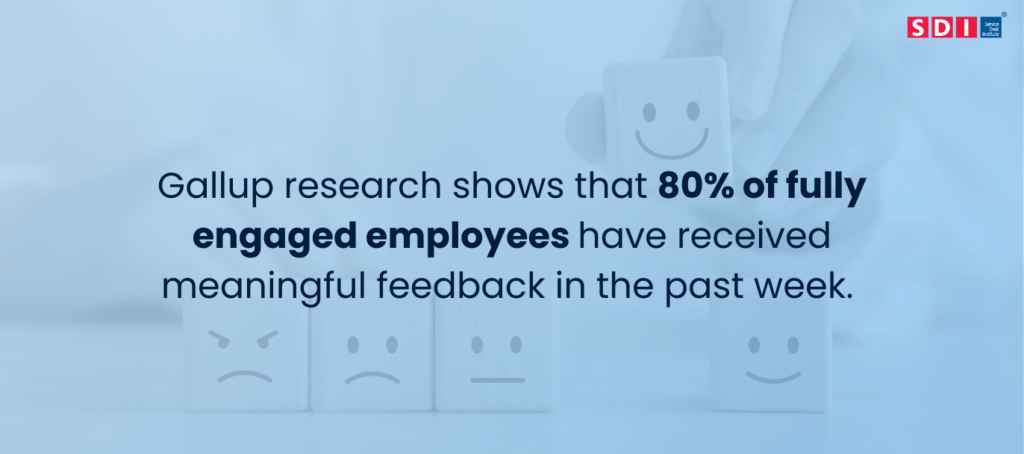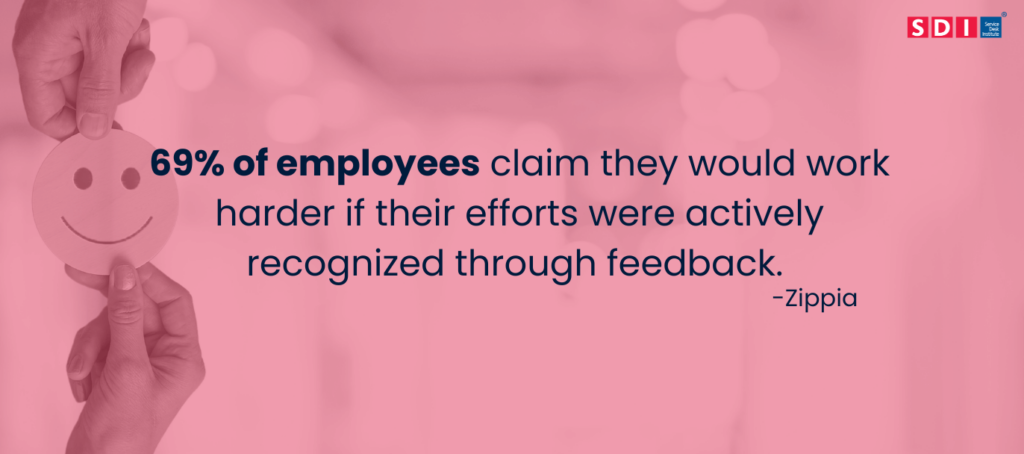 Back to Resources
Back to Resources
Gathering employee feedback is one step towards creating a positive feedback culture and a more diverse and inclusive workplace. By engaging in open dialogue with employees, you can identify and address their concerns and implement solutions to enhance their overall experience, satisfaction, and productivity. But gathering feedback alone is not enough!
It’s important to truly understand what is being said and turn those insights into actionable steps. So, how do you do that effectively? In this blog, we’ll explore the relationship between employee feedback and experience and share some tips on creating an effective feedback culture.
What’s the link between employee feedback and employee experience?
The employee experience involves everything that employees encounter, observe, and feel at an organisation. Basically, it’s a view of an employee’s journey, from their initial onboarding process to their eventual exit. It includes their daily interactions and overall perceptions of the workplace. But what is necessary to provide an excellent employee experience? Is it the best available technology or processes? Or engaged and motivated people?
The answer is always – people first!
For example, in IT support, the service desk team is incredibly important to the quality of service delivered and experience. That’s why companies need to gather employee feedback.
The importance of employee feedback
Employee feedback is a powerful source of insight that gives you a deep understanding of your employee experience. It can be considered an important benchmark for discovering what employees truly think and feel about working at the company. It can help you see what you are doing well (areas of excellence) and where improvement is needed. This information is vital for continuous improvement and creating a better workplace experience.
Employee engagement is also closely tied to how valued and heard employees feel. Feedback mechanisms allow employees to express their connection to their work and the organisation, offering a measure of their engagement levels. Most companies focus on collecting feedback from their employees, but it’s equally important to provide feedback to them. It’s about creating a culture where feedback flows freely in both directions.
Why?
Effective feedback drives higher levels of satisfaction, efficiency, and success. It also enhances service quality and employee experience, empowers employees, drives continuous improvement, improves customer satisfaction, and builds a culture of trust and credibility. Let’s look at some positive effects of creating a feedback culture.
Enhanced employee performance and morale

Research shows that continuous feedback can help increase motivation, attitudes, and employee experience. On the other side, when employees are not asked to voice their opinions or receive little to no feedback, they become disengaged from their work. The result? Being disengaged for a long time increases the chance of employees becoming unsatisfied, stagnant, and eventually leaving their jobs. Regular feedback can also be a good motivational tool.
“According to a Zippia study, 85% of employees take more initiative when they receive feedback in the workplace.”
When employees feel valued, listened to, and understand their role in the company’s success, they care more about the work and are more engaged. Gallup research shows that 80% of fully engaged employees have received meaningful feedback in the past week. In IT support, where technology and customer needs are constantly evolving, feedback helps employees refine their skills to meet these changing demands. It can also be considered as a roadmap for personal and professional development.
Increased productivity

Feedback is essential in learning and development and an important part of building a high-performance culture. Employee feedback can highlight inefficiencies in service processes or areas where employees may need additional training. For example, IT teams may consistently provide feedback on needing a new and updated ITSM tool to improve efficiency and streamline processes. Acting on this feedback can not only benefit the IT team and positively impact their productivity and performance, but it can also enhance the organisation’s overall performance.
Improved customer satisfaction and loyalty
Employees are often the first to identify and address customer issues and concerns. As a result, they can usually provide valuable insights into areas where service quality can be enhanced. So, listening to employee feedback about customer preferences, needs, and pain points can really help organisations tailor their service delivery to individual customer requirements. On the other hand, we already know how giving regular employee feedback positively impacts their experience and performance. So, encouraging this ongoing feedback exchange can promote continuous improvement and enhance overall communication and collaboration. Remember, having happy and engaged employees can significantly contribute to increased customer loyalty and satisfaction.
⚡ Tips for creating effective feedback culture
Here are a few simple tips to help you create a feedback culture and encourage your team to provide and receive feedback more openly:
✅ When employees provide feedback (positive or negative), it is very important to listen actively without any assumptions or judgments. Acknowledging feedback, regardless of feasibility, and acting on it accordingly can empower your team.
✅ It’s best to use a variety of methods when collecting feedback, such as employee engagement surveys, one-on-one meetings, peer check-ins, performance reviews, pulse surveys and focus groups.
✅ Set up a real-time feedback program to provide relevant and timely insights. But make sure that the program is aligned with your organisational goals and doesn’t overwhelm employees or disrupt their work.
✅ Encourage dialogue by asking specific and open-ended questions that invite constructive feedback. This shows you value your team’s opinions and insights.
✅ Understand that some team members may prefer receiving feedback in private, while others might be comfortable with public acknowledgement.
✅ Use anonymous surveys to collect honest feedback about management and team dynamics. This can help address issues that team members may hesitate to voice openly.
✅ Provide clear guidelines on how to give constructive feedback. This helps in making the feedback process more structured and less daunting.
✅ Show that you take feedback seriously by acting on it when appropriate. Implement changes based on the feedback you receive, but don’t forget to communicate these actions to the team.
📕 Read more: Best Practice for Managing Service Desk Teams [+ Case Study Examples]
Put feedback into action
Employee feedback is like a bridge that connects companies’ intentions with employees’ actual experiences. By creating a feedback culture where employees can share their thoughts and feelings, you can gain a deeper understanding of employee experience. This understanding, in turn, can help you establish a more engaging, supportive, effective, and fulfilling workplace environment. Remember, gathering opinions, concerns, and ideas from employees is important, but acting on these insights is essential for continuous improvement! It ensures that your organisation evolves in ways that enhance the employee experience.















